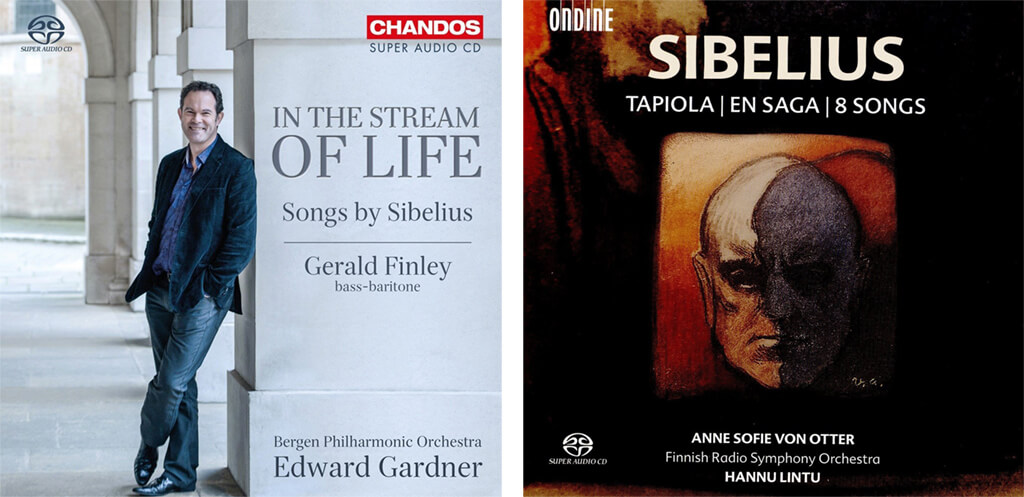
Over the course of his life, Sibelius wrote over 100 songs, most of which are little-known and infrequently performed.
Years ago, I had the pleasure of collaborating with the great Finnish baritone Jorma Hynninen in a concert of Sibelius’ music at Toronto’s Massey Hall — an unforgettable experience, in which Hynninen brought several of the composer’s songs to life with palpable intensity. Although Hynninen recorded an album of Sibelius songs (Ondine ODE 823-2), the field has remained wide open for other artists to take an interest. These new CDs featuring Gerald Finley and Anne Sofie von Otter respectively could be enormously helpful in bringing this neglected repertoire to a wider audience.
Sibelius wrote most of his songs for voice with piano accompaniment. While he later orchestrated several of these scores, dozens more cry out for the colours attainable through symphonic orchestration.
Happily, Canadian bass-baritone Gerald Finley developed a friendship with the celebrated Finnish composer Eino Rautavaara (2013-2016), which led to Rautavaara orchestrating a Sibelius song as a gift to Finley. Finley then persuaded Rautavaara to orchestrate more songs, which led him to complete — just before his death in 2016 — a set of seven Sibelius songs, grouped under the title In the Stream of Life. The last song in the set is “Svarta rosor” (Black Roses), perhaps the most famous of all the Sibelius songs.
Rautavaara’s orchestral accompaniments, all very much in Sibelius’ own style, rarely draw attention to themselves. Finley, who performs the songs with beautiful tone, stylish phrasing and with an authority and passion similar to that of the now retired Hynninen, should be considered his worthy successor in this repertoire.
The new Ondine disc, featuring Swedish artist Anne Sofie von Otter, includes eight Sibelius songs orchestrated by another prominent Finnish composer, Aulis Sallinen. Commissioned by the Finnish Radio Symphony Orchestra and Hannu Lintu, these orchestrations were premiered with Anne Sofie von Otter in 2015. Only one of the songs on this disc — “Jägargossen” (The Young Huntsman) — is also to be found on the Chandos Finley CD. On listening to both performances in succession, I was struck by the orchestral similarities; apparently, Rautavaara and Sallinen hear Sibelius in much the same way. In both versions, the timpani is used prominently in the opening and closing bars but nowhere in between, and in both, the clarinet is used very effectively; that said, “Jägargossen” is very much a man’s song and Finley’s performance sounds much more idiomatic.
In some of the quieter songs orchestrated by Sallinen, Anne Sofie von Otter sings beautifully, with the rich tone we have come to admire over the years, while Lintu and his orchestra provide sympathetic accompaniments. On the whole, however, it is Finley on the Chandos CD who provides more eloquent and powerful performances, especially in “The Rapids-rider’s Brides” and “The Diamond on the March Snow.” Finley also includes “Hymn to Thaïs, the Unforgettable,” the only song by Sibelius based on an English text.
Each of these new recordings is filled out with several orchestral pieces. On the Chandos CD, Edward Gardner conducts strong performances of Pohjola’s Daughter, the Romance in C major for strings and the impressionistic tone poem The Oceanides. On the Ondine CD, Hannu Lintu conducts Tapiola and En Saga, an early tone poem from 1892, which has a strikingly original cymbal part — the player uses timpani sticks — a sound Sibelius blends with soft strings near the opening of the piece and again at the end, for a magical, unearthly effect which Lintu and the Ondine engineers capture perfectly.
LUDWIG VAN TORONTO
Want more updates on Toronto-centric classical music news and reviews before anyone else finds out? Follow us on Facebook or Twitter for all the latest.
![]()
- SCRUTINY | TSO Lets Berlioz Do The Talking In Season Opener - September 21, 2018
- RECORD KEEPING | Even Yannick Nézet-Séguin Can’t Make Us Love Mozart’s La Clemenza di Tito - September 6, 2018
- RECORD KEEPING | Giovanna d’Arco With Anna Netrebko Explains Why The Best Operas Survive - August 30, 2018



